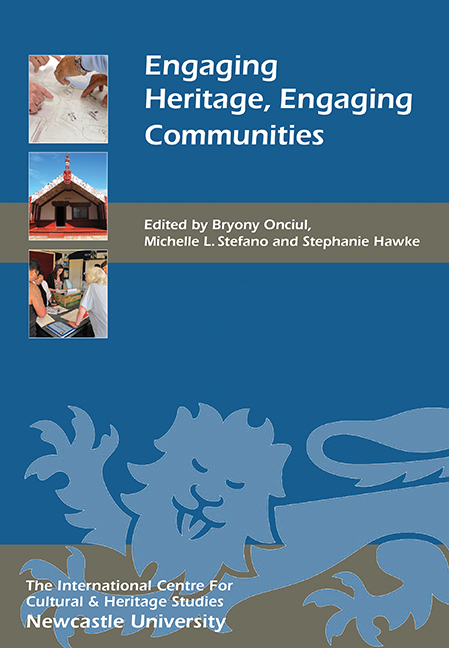Book contents
- Frontmatter
- Contents
- List of Illustrations
- Acknowledgments
- Introduction
- Engaging Concepts
- Engaging Creatively
- 7 Re-imagining Egypt: Artefacts, Contemporary Art and Community Engagement in the Museum
- 8 Interview – Evita Buša
- 9 Interview – Shatha Abu Khafajah
- 10 Engaging Communities of De–industrialisation: the Mapping Baybrook and Mill Stories Projects of Baltimore, USA
- 11 Interview – Ashley Minner
- Engaging Challenges
- List of Contributors
- Index
- Miscellaneous Endmatter
9 - Interview – Shatha Abu Khafajah
from Engaging Creatively
Published online by Cambridge University Press: 13 April 2017
- Frontmatter
- Contents
- List of Illustrations
- Acknowledgments
- Introduction
- Engaging Concepts
- Engaging Creatively
- 7 Re-imagining Egypt: Artefacts, Contemporary Art and Community Engagement in the Museum
- 8 Interview – Evita Buša
- 9 Interview – Shatha Abu Khafajah
- 10 Engaging Communities of De–industrialisation: the Mapping Baybrook and Mill Stories Projects of Baltimore, USA
- 11 Interview – Ashley Minner
- Engaging Challenges
- List of Contributors
- Index
- Miscellaneous Endmatter
Summary
Could you reflect on your career so far, focusing on your work on heritage?
I work in the architecture department at the Hashemite University in Jordan. The department takes an interdisciplinary approach to architecture, and part of this approach is viewing material of the past, especially architecture, as a source of education, inspiration and creativity. Therefore, students, at their different learning stages, are strongly encouraged to critically examine and thoroughly analyse material of the past and use this analysis in their creations of new concepts, technologies and solutions in architectural design. This engagement qualifies material from the past to become heritage.
The department provides two heritage specialised modules focusing on the basics of heritage conservation and management. They help the students to gain basic knowledge and decide if they want to pursue future degrees in heritage. We design the modules to help the students to harness their basic knowledge of heritage to approach certain local heritage sites. The approach is usually in two stages: the first is based on conventional identification and evaluation of the sites, and the second is based on creating material (we call it creative material, such as models, interpretation signs and 3-dimensional reconstruction animated videos) out of this engagement. The first time we taught a heritage specialised module the students noted that they used the creative material to communicate with their families about the heritage sites, and reported the excitement and knowledge the material initiated among their families. This inspired us to alter the second stage in the coming courses to include a presentation day in which the students presented the creative material to other students in the university. The students organised an exhibition for this in the available open spaces there. They then used the feedback they received from this communication to improve the creative material they generated in the first stage of the project, and made it reflect local communities’ knowledge, feelings, imagination and attachment to the sites in question.
The presentation day provided an opportunity to create a supportive audience of heritage within the university not only among the department students but also among other students. In addition, the experience was an enjoyable activity through which our students gained skills in communicating heritage to others. In fact, many students decided after the presentation day that they were seriously considering heritage for their postgraduate studies.
- Type
- Chapter
- Information
- Engaging Heritage, Engaging Communities , pp. 113 - 118Publisher: Boydell & BrewerPrint publication year: 2017



